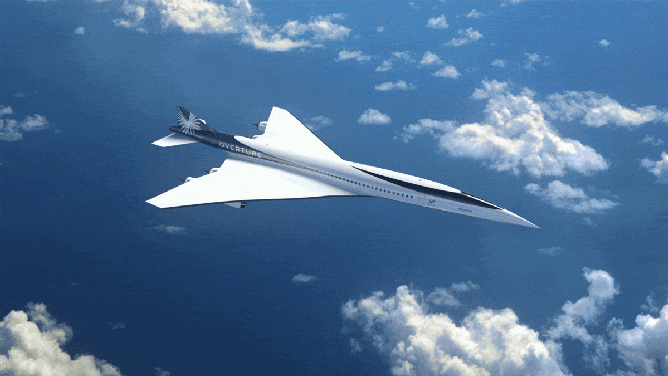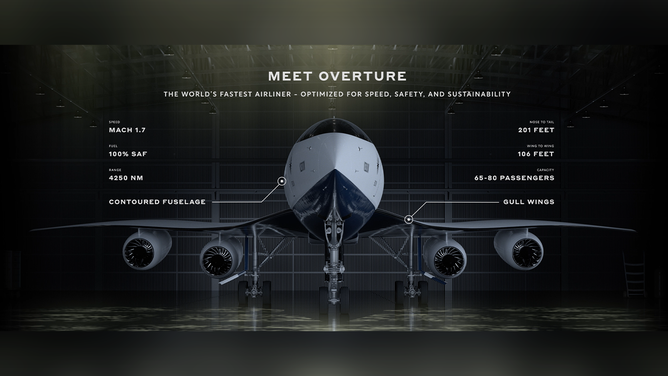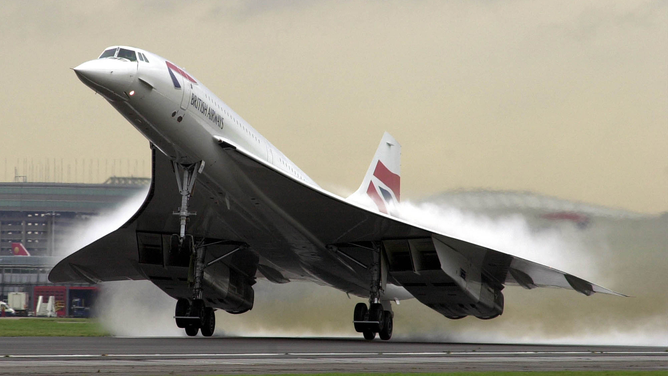New airliner ‘Overture’ ushers in era of supersonic travel with major airlines committing to purchasing fleets
Meet Overture – the world’s fastest airliner that was developed by Denver-based Boom Supersonic.
Watch: New airliner aims to usher in new era of supersonic travel
Overture was designed by Boom Technology and aims to usher in a new era of supersonic travel by transporting passengers from places like New York City to London in only a few hours.
The world hasn't seen commercial supersonic travel in nearly 20 years since the Concorde was retired in 2003, but all that is about to change with the development of a new, environmentally friendly airliner.
Meet Overture – the world's fastest airliner that was developed by Denver-based Boom Supersonic.
HOW TO WATCH FOX WEATHER ON TV
With 26 million hours of designing and testing, Overture will run on 100% sustainable aviation fuel (SAF) as it flies at Mach 1.7 over the ocean, shuttling between 68-80 passengers up to nearly 5,000 miles.
The updated design features four engines that will keep weight and temperature balanced, which will also lower the size requirements of the wing-mounted engines.
Boom says that smaller engines will lower the thrust requirements for each one.
And the lower the thrust – the quieter they will run.
"With no afterburners and buzz-free engines, Overture's takeoffs will blend in with existing long-haul fleets, resulting in a quieter experience for both passengers and airport communities," Boom said on its website.
The signature sonic boom people hear when an aircraft goes supersonic can rattle nerves and windows. But unlike the Concorde, Overture's sonic boom would be heard over the ocean as to not disturb people on the ground.
Net zero carbon and SAF

Overture's engines will run on 100% sustainable aviation fuel as it flies at Mach 1.7.
(Boom Supersonic)
Boom says the environmental impacts of Overture were taken into consideration when designing the new airliner, and that will aid the company in its journey to achieving net zero carbon by 2025.
"Environmental performance is being considered in all aspects of Overture, from design and production to flight and end-of-life recycling," Boom said on its website. "The engineering team prioritizes circularity by repurposing used tooling, recycling components on the shop floor and leveraging additive manufacturing techniques that result in less manufacturing waste and lighter, more fuel-efficient products."
In its design, Overture will incorporate lighter, stronger and thermally stable carbon composite materials into most of its construction.
A lighter aircraft will make the airliner more fuel efficient, making it more sustainable for the environment.
Another environmentally friendly aspect of Overture is the use of sustainable aviation fuel.
What is SAF?
SAF delivers the same performance as conventional jet fuel but with a significantly smaller carbon footprint.
The fuel comprises different types of sustainable resources, such as used cooking oil and animal fat waste, to name a few.
UNITED AIRLINES TO START USING FUEL MADE OF ANIMAL FAT, COOKING OIL ON SOME FLIGHTS
Fuselage and gull-wing design

Overture has been optimized for speed, safety and sustainability.
Overture's fuselage has a larger diameter in the front of the aircraft and a smaller diameter toward the back, which minimizes drag and maximizes its fuel efficiency as it cruises at supersonic speeds.
In addition, Boom says the gull-wing design will allow the air to flow smoothly around and over the aircraft.
That will enhance the airplane's supersonic flight ability while remaining efficient at slower speeds.
Boom says the benefit of the design of the wing and its ability to fly slower means higher overall safety as it will take off and land at slower speeds.
AIRBUS A380 SUCCESSFULLY COMPLETES FLIGHT POWERED BY COOKING OIL
Travel times
So far, Boom says three airlines and the United States Air Force have signed on to purchase Overture airlines.
American Airlines has become the most recent airline to announce an agreement with Boom to purchase 20 Overture supersonic aircraft with an option to purchase 40 more.
That announcement was made on Aug. 16.
American, which is the world’s largest airline, would then have the world’s largest supersonic airliner fleet, according to Boom.
United Airlines has previously entered into an agreement with Boom to purchase 15 Overture airliners, with an option to buy an additional 35 aircraft.
Japan Airlines has also announced it would buy the airliners and has pre-ordered 20.
In addition, Boom and the United States Air Force are currently developing custom Overture configurations for government transportation.
So, how long will it take to get to popular international destinations?
New York City to London:
- Current travel time: Approximately 7 hours
- Overture travel time: 3 hours 30 minutes
Los Angeles to Sydney:
- Current travel time: Approximately 15 hours
- Overture travel time: 8 hours
Tokyo to Seattle:
- Current travel time: Approximately 9 hours
- Overture travel time: 4 hours 30 minutes
Boom says it's hoping to roll out Overture in 2025 and begin to carry its first passengers by 2029.
The Concorde

FILE - A British Airways Concorde takes off from Heathrow airport November 7, 2001 in London, United Kingdom.
(Getty Images)
The Concorde was the world's first supersonic passenger airplane. Both British Airways and Air France used them commercially between 1976 and 2003.
The airliners shuttled passengers all over the world, but the aircraft's extremely loud operation and the cost to operate limited its service.
Its cruising speed was faster than Overture, zooming around the world twice the speed of sound at Mach 2.04.
At that speed, a flight between New York City and London was about 3 hours.
However, the Concorde wasn't financially profitable.
And in 2000, a Concorde flight from Paris to New York City crashed shortly after takeoff when debris on the runway was kicked up into the plane's fuselage and ruptured a fuel take.
The result was a catastrophic fire as the plane lifted off the runway.
It crashed into a hotel and restaurant a few miles from the airport, killing all 109 people on board and four people on the ground.
After that, both Air France and British Airways announced they would retire their Concorde fleets.
Flights with the Concorde stopped in 2003, and commercial supersonic flights have been a memory ever since.
